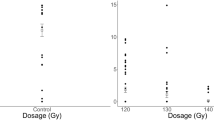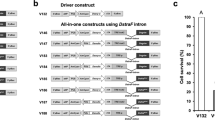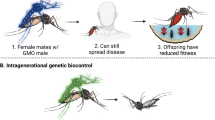Abstract
Biological approaches to insect pest management offer alternatives to pesticidal control. In area-wide control programs that cover entire regions, the sterile insect technique (SIT) can be used to successfully suppress economically important pest species by the mass release of sterilized pest organisms. However, conventional sterilization by ionizing radiation reduces insect fitness, which can result in reduced competitiveness of the sterilized insects. Here we report a transgene-based, dominant embryonic lethality system that allows for generation of large quantities of competitive but sterile insects without the need of irradiation. The system involves the ectopic expression of a hyperactive pro-apoptotic gene that causes embryo-specific lethality when driven by the tetracycline-controlled transactivator (tTA) under the regulation of a cellularization gene enhancer-promoter. We have successfully tested this system in Drosophila melanogaster. The embryonic lethality can be suppressed maternally, which will allow it to be combined with transgenic female-specific lethality systems to raise only vigorous but sterile males.
This is a preview of subscription content, access via your institution
Access options
Subscribe to this journal
Receive 12 print issues and online access
$259.00 per year
only $21.58 per issue
Buy this article
- Purchase on SpringerLink
- Instant access to full article PDF
Prices may be subject to local taxes which are calculated during checkout





Similar content being viewed by others
References
Knipling, E.F. Possibilities of insect control or eradication through the use of sexually sterile males. J. Econ. Entomol. 48, 459–462 (1955).
Krafsur, E.S. Sterile insect technique for suppressing and eradicating insect population: 55 years and counting. J. Agric. Entomol. 15, 303–317 (1998).
Walters, M.L., Staten, R.T. & Roberson, R.C. Pink bollworm integrated management using sterile insects under field trial conditions, Imperial Valley, California. in Area-Wide Control of Fruit Flies and Other Insect Pests (ed. Tan, K.H.) 201–206 (Penerbit Universiti Sains Malaysia, Penang, Malaysia, 2000).
Vreysen, M.J. Principles of area-wide integrated tsetse fly control using the sterile insect technique. Med. Trop. 61, 397–411 (2001).
Wyss, J.H. Screwworm eradication in the Americas—overview. in Area-Wide Control of Fruit Flies and Other Insect Pests (ed. Tan, K.H.) 79–86 (Penerbit Universiti Sains Malaysia, Penang, Malaysia, 2000).
Klassen, W., Lindquist, D.A. & Buyckx, E.J. Overview of the Joint FAO/IAEA Division's involvement in fruit fly sterile insect technique programs. in Fruit Flies and the Sterile Insect Technique (eds. Calkins, C.O., Klassen, W. & Liedo, P.) 3–26 (CRC Press, Boca Raton, FL, 1994).
Hendrichs, J., Franz, G. & Rendon, P. Increased effectiveness and applicability of the sterile insect technique through male-only releases for control of Mediterranean fruit flies during fruiting seasons. J. Appl. Entomol. 119, 371–377 (1995).
Robinson, A.S., Franz, G. & Fisher, K. Genetic sexing strains in the medfly, Ceratitis capitata: development, mass rearing and field application. Trends Entomol. 2, 81–104 (1999).
Atkinson, P.W., Pinkerton, A.C. & O'Brochta, D.A. Genetic transformation systems in insects. Annu. Rev. Entomol. 46, 317–346 (2001).
Handler, A.M. A current perspective on insect gene transformation. Insect Biochem. Mol. Biol. 31, 111–128 (2001).
Horn, C., Schmid, B.G.M., Pogoda, F.S. & Wimmer, E.A. Fluorescent transformation markers for insect transgenesis. Insect Biochem. Mol. Biol. 32, 1221–1235 (2002).
Heinrich, J.C. & Scott, M.J. A repressible female-specific lethal genetic system for making transgenic insect strains suitable for a sterile-release program. Proc. Natl. Acad. Sci. USA 97, 8229–8232 (2000).
Thomas, D.D., Donnelly, C.A., Wood, R.J. & Alphey, L.S. Insect population control using a dominant, repressible, lethal genetic system. Science 287, 2474–2476 (2000).
Holbrook, F.R. & Fujimoto, M.S. Mating competitiveness of unirradiated and irradiated Mediterranean fruit flies. J. Econ. Entomol. 63, 1175–1176 (1970).
Hooper, G.H.S. & Katiyar, K.P. Competitiveness of gamma-sterilized males of the Mediterranean fruit flies. J. Econ. Entomol. 64, 1068–1071 (1971).
Cayol, J.P., Vilardi, J., Rial, E. & Vera, M.T. New indices and method to measure the sexual compatibility and mating performance of Ceratitis capitata (Diptera: Tephritidae) laboratory-reared strains under field cage conditions. J. Econ. Entomol. 92, 140–145 (1999).
Mayer, D.G., Atzeni, M.G., Stuart, M.A., Anaman, K.A. & Butler, D.G. Mating competitiveness of irradiated flies for screwworm fly eradication campaigns. Prev. Vet. Med. 36, 1–9 (1998).
Pedigo, L.P. Entomology and Pest Management (Prentice Hall, Upper Saddle River, 1996).
Grether, M.E., Abrams, J.M., Agapite, J., White, K. & Steller, H. The head involution defective gene of Drosophila melanogaster functions in programmed cell death. Genes Dev. 9, 1694–1708 (1995).
Bergmann, A., Agapite, J., McCall, K. & Steller, H. The Drosophila gene hid is a direct molecular target of Ras-dependent survival signaling. Cell 95, 331–341 (1998).
Ibnsouda, S., Schweisguth, F., de Billy, G. & Vincent, A. Relationship between expression of serendipity α and cellularisation of the Drosophila embryo as revealed by interspecific transformation. Development 119, 471–483 (1993).
Postner, M.A. & Wieschaus, E.F. The nullo protein is a component of the actin-myosin network that mediates cellularization in Drosophila melanogaster embryos. J. Cell Sci. 107, 1863–1873 (1994).
Gossen, M. & Bujard, H. Tight control of gene expression in mammalian cells by tetracycline-responsive promoters. Proc. Natl. Acad. Sci. USA 89, 5547–5551 (1992).
Vincent, A., Colot, H.V. & Rosbash, M. Blastoderm-specific and read-through transcription of the sryα gene transformed into the Drosophila genome. Dev. Biol. 118, 480–487 (1986).
Rose, L.S. & Wieschaus, E. The Drosophila cellularization gene nullo produces a blastoderm-specific transcript whose levels respond to the nucleocytoplasmic ratio. Genes Dev. 6, 1255–1268 (1992).
Chung, J.H., Whiteley, M. & Felsenfeld, G. A 5′ element of the chicken β-globin domain serves as an insulator in human erythroid cells and protects against position effect in Drosophila. Cell 74, 505–514 (1993).
Ibnsouda, S. et al. Evolutionarily conserved positive and negative cis-acting elements control the blastoderm-specific expression of the Drosophila serendipity α cellularisation gene. Mech. Dev. 49, 71–82 (1995).
Bello, B., Resendez-Perez, D. & Gehring, W.J. Spatial and temporal targeting of gene expression in Drosophila by means of a tetracycline-dependent transactivator system. Development 125, 2193–2202 (1998).
Conforti, E., Torti, C., Malacrida, A.R. & Bernocchi, G. Mature and developing visual system of Ceratitis capitata (Diptera, Tephritidae): histochemical evidence of nitric oxide synthase in the wild type and the white eye mutant strains. Brain Res. 843, 1–11 (1999).
Horn, C. & Wimmer, E.A. A versatile vector set for animal transgenesis. Dev. Genes Evol. 210, 630–637 (2000).
Berghammer, A.J., Klingler, M. & Wimmer, E.A. A universal marker for transgenic insects. Nature 402, 370–371 (1999).
Robinson, A.S. & Franz, G. The application of transgenic insect technology in the sterile insect technique. in Insect Transgenesis: Methods and Applications (eds. Handler, A.M. & James, A.A.) 307–318 (CRC Press, Boca Raton, FL, 2000).
Hagler, J.R. & Jackson, C.G. Methods for marking insects: current techniques and future prospects. Annu. Rev. Entomol. 46, 511–543 (2001).
Horn, C., Offen, N., Nystedt, S., Häcker, U. & Wimmer, E.A. piggyBac-based insertional mutagenesis and enhancer detection as a tool for functional insect genomics. Genetics in press (2003).
Rørth, P. Gal4 in the Drosophila female germline. Mech. Dev. 78, 113–118 (1998).
Thummel, C. & Pirrotta, V. New pCaSpeR P-element-vectors. Dros. Inf. Serv. 71, 150 (1992).
Hunter, C., Sung, P., Schejter, E.D. & Wieschaus, E. Conserved domains of the nullo protein required for cell-surface localization and formation of adherens junctions. Mol. Biol. Cell 13, 146–157 (2002).
Horn, C., Jaunich, B. & Wimmer, E.A. Highly sensitive, fluorescent transformation marker for Drosophila transgenesis. Dev. Genes Evol. 210, 623–629 (2000).
Roberts, D.B. Drosophila: A Practical Approach (IRL Press, Oxford, 1998).
Lehner, C.F. & O'Farrell, P.H. Drosophila cdc2 homologs: a functional homolog is coexpressed with a cognate variant. EMBO J. 9, 3573–3581 (1990).
Davis, G.K., Jaramillo, C.A. & Patel, N.H. Pax group III genes and the evolution of insect pair-rule patterning. Development 128, 3445–3458 (2001).
Wang, S.L., Hawkins, C.J., Yoo, S.J., Muller, H.A. & Hay, B.A. The Drosophila caspase inhibitor DIAP1 is essential for cell survival and is negatively regulated by HID. Cell 98, 453–463 (1999).
Acknowledgements
We are very grateful to Brigitte Jaunich for technical assistance and express our thanks to A. Bergmann, H. Bujard, U. Häcker, C.F. Lehner, S. Nystedt, P. Rørth, P. Sung, and E. Wieschaus for providing plasmids. We thank C.F. Lehner and the members of the Lehrstuhl Genetik for support, encouragement, and discussions during the course of our work, which is supported by the Robert Bosch Foundation. C.H. is a fellow of the Fonds der Chemischen Industrie, partially supported by the BMBF, and E.A.W. acknowledges support from the EMBO Young Investigator Programme.
Author information
Authors and Affiliations
Corresponding author
Ethics declarations
Competing interests
The authors declare no competing financial interests.
Rights and permissions
About this article
Cite this article
Horn, C., Wimmer, E. A transgene-based, embryo-specific lethality system for insect pest management. Nat Biotechnol 21, 64–70 (2003). https://doi.org/10.1038/nbt769
Received:
Accepted:
Published:
Issue date:
DOI: https://doi.org/10.1038/nbt769
This article is cited by
-
Sequence and expression analysis of the spermatogenesis-specific gene cognates, wampa and Prosα6T, in Drosophila suzukii
Genetica (2023)
-
A transgenic female killing system for the genetic control of Drosophila suzukii
Scientific Reports (2021)
-
Identification and characterization of four Drosophila suzukii cellularization genes and their promoters
BMC Genetics (2020)
-
An early female lethal system of the New World screwworm, Cochliomyia hominivorax, for biotechnology-enhanced SIT
BMC Genetics (2020)
-
Improvement on the genetic engineering of an invasive agricultural pest insect, the cherry vinegar fly, Drosophila suzukii
BMC Genetics (2020)



